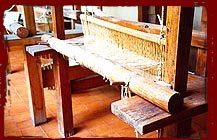 |

Cleaning &
Carding
"
To begin, we buy wool that's matted together. We buy
it because
we don't have sheep. The matted wool comes very dirty,
so we clean
it thoroughly; we pull it apart and wash it in the river. We drain it in
the sand and then hang it up to dry. After it's dry, we begin the carding.
Spinning
We card the wool,we
spin it to make yarn, and then we prepare the madejas (coiled yarn),
as we call them.
Dyeing
After the madejas (coiled yarn),
we wash it for dyeing. The natural colors, we only wash them and they are ready for use,
but for the
dyeing we have to wash the wool and prepare it for
the dye.

Weaving the Rug
After the dyeing we prepare
small spools to be able to weave. One
begins to work, to combine colors and to think, how
this design will
look with these colors. Or at times we have a design
at hand but then we see that the colors aren't right for the design
so we change them. Or many times too, we work only with the colors and
we begin to get ideas this way too. Now we have the work, the beginning,
we the change the idea too if it doesn't come--a thought,
an image--and we begin.
|
 |


The looms used in weaving the rugs
of the Zapotecs consist of several parts:
The knee
(el rodillo):
The yarn that wraps around the knee
keeps it from bending.
The comb (el peine):
Combs are made of bamboo and aluminum Bamboo combs
run the risk of breaking, while aluminum combs bend
easily. Without use, aluminum combs oxidize and the
bamboo combs deteriorate.
The other knee (otro rodillo):
Its purpose is to adjust or loosen the yarn
(el urdimbre).
The pedals (los pedales):
One drives the weaving with the pedals. |
 |